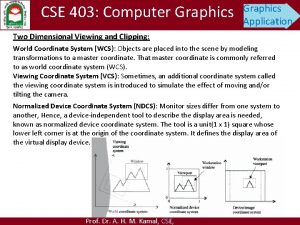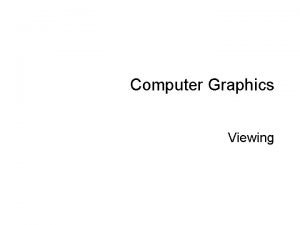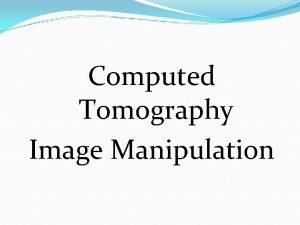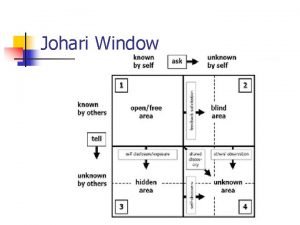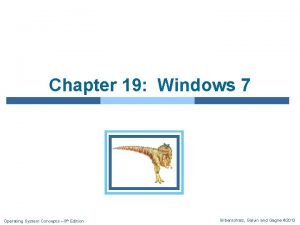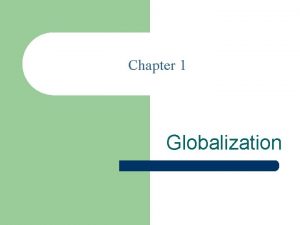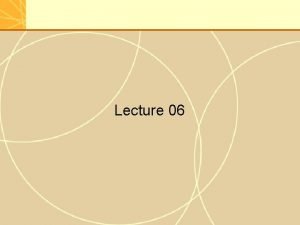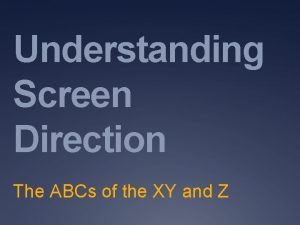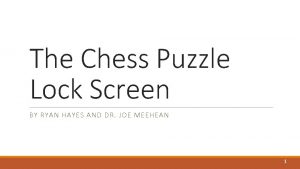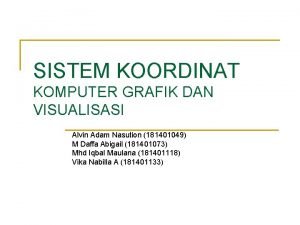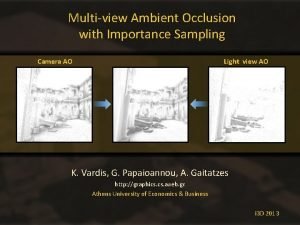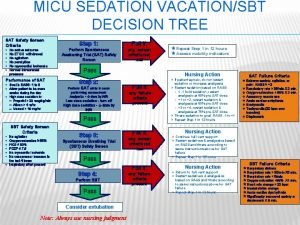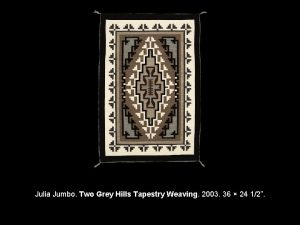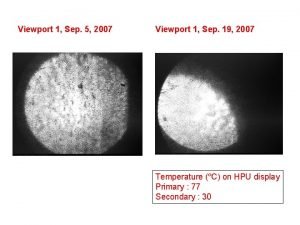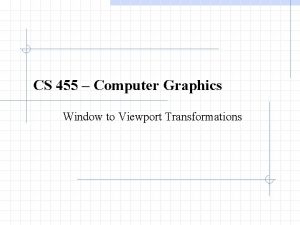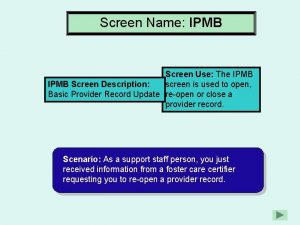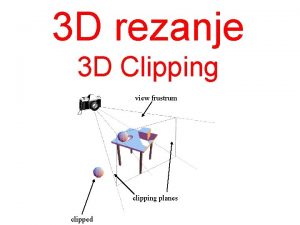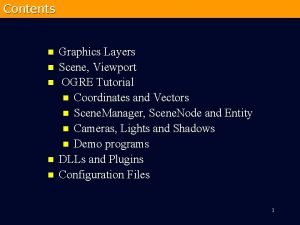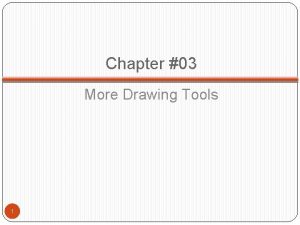Rezanje rt in poligonov World window viewport screen









![Algoritem Cyrus-Beck NL [P(t) - PL] = 0 PL P(t) P 0 Inside NL Algoritem Cyrus-Beck NL [P(t) - PL] = 0 PL P(t) P 0 Inside NL](https://slidetodoc.com/presentation_image/58b91e72944544cfc8de68446de36ed8/image-10.jpg)







































- Slides: 49

Rezanje črt in poligonov

World window & viewport screen window world window viewport

Clipping We have talked about 2 D scan conversion of line-segments and polygons What if endpoints of line segments or vertices of polygons lie outside the visible device region? Need clipping!

Clipping of primitives is done usually before scan converting the primitives Reasons being § scan conversion needs to deal only with the clipped version of the primitive, which might be much smaller than its unclipped version § Primitives are usually defined in the real world, and their mapping from the real to the integer domain of the display might result in the overflowing of the integer values resulting in unnecessary artifacts

Clipping: Remove points outside a region of interest. § Want to discard everything that’s outside of our window. . . Point clipping: Remove points outside window. § A point is either entirely inside the region or not. Line clipping: Remove portion of line segment outside window. § Line segments can straddle the region boundary. § Liang-Barsky algorithm efficiently clips line segments to a halfspace. § Halfspaces can be combined to bound a convex region. § Use outcodes to better organize combinations of halfspaces. § Can use some of the ideas in Liang-Barsky to clip points.

Clipping Lines outside of world window are not to be drawn. Graphics API clips them automatically. But clipping is a general tool in graphics!

Rezanje (clipping) Cohen-Sutherland § Uporaba kode za hitro izločanje črt § Izračun rezanja preostalih črt z oknom gledanja – Introduced parametric equations of lines to perform edge/viewport intersection tests – Truth in advertising, Cohen-Sutherland doesn’t use parametric equations of lines § Viewport intersection code: – (x 1, y 1), (x 2, y 2) intersect with vertical edge at xright – yintersect = y 1 + m(xright – x 1), m=(y 2 -y 1)/(x 2 -x 1) – (x 1, y 1), (x 2, y 2) intersect with horizontal edge at ybottom – xintersect = x 1 + (ybottom – y 1)/m, m=(y 2 -y 1)/(x 2 -x 1)

Parametrične enačbe Faster line clippers use parametric equations Line 0: § x 0 = x 00 + (x 01 - x 00) t 0 § y 0 = y 00 + (y 01 - y 00) t 0 Viewport Edge L: § x. L = x. L 0 + (x. L 1 - x. L 0) t. L § y. L = y. L 0 + (y. L 1 - y. L 0) t. L x 00 + (x 01 - x 00) t 0 = x. L 0 + (x. L 1 - x. L 0) t. L y 00 + (y 01 - y 00) t 0 = y. L 0 + (y. L 1 - y. L 0) t. L § Solve for t 0 and/or t. L

Algoritem Cyrus-Beck Use parametric equations of lines Optimize We saw that this could be expensive… Start with parametric equation of line: § P(t) = P 0 + (P 1 - P 0) t And a point and normal for each edge § PL , N L
![Algoritem CyrusBeck NL Pt PL 0 PL Pt P 0 Inside NL Algoritem Cyrus-Beck NL [P(t) - PL] = 0 PL P(t) P 0 Inside NL](https://slidetodoc.com/presentation_image/58b91e72944544cfc8de68446de36ed8/image-10.jpg)
Algoritem Cyrus-Beck NL [P(t) - PL] = 0 PL P(t) P 0 Inside NL Substitute line equation for P(t) Solve for t § t = NL [P 0 - PL] / -NL [P 1 - P 0] P 1

Algoritem Cyrus-Beck Compute t for line intersection with all four edges Discard all (t < 0) and (t > 1) Classify each remaining intersection as § Potentially Entering (PE) § Potentially Leaving (PL) NL [P 1 - P 0] > 0 implies PL NL [P 1 - P 0] < 0 implies PE § Note that we computed this term in when computing t

Algoritem Cyrus-Beck Compute PE with largest t Compute PL with smallest t Clip to these two points PL PE P 0 PE PL P 1

Algoritem Cyrus-Beck Because of horizontal and vertical clip lines: § Many computations reduce Normals: (-1, 0), (0, -1), (0, 1) Pick constant points on edges solution for t: § -(x 0 - xleft) / (x 1 - x 0) § (x 0 - xright) / -(x 1 - x 0) § -(y 0 - ybottom) / (y 1 - y 0) § (y 0 - ytop) / -(y 1 - y 0)

Cohen-Sutherland region outcodes 4 bits: TTFF Left of window? Above window? Right of window? Below window?

Cohen-Sutherland region outcodes TTFF FTTF TFFF FFTF TFFT FFTT Trivial accept: both endpoints are FFFF Trivial reject: both endpoints have T in the same position

Cohen-Sutherland Algorithm Half space code (x < x 2) | (x > x 1) | (y > y 1) | (y < y 2) 0 0001 0101 (x 2, y 2) (x 1, y 2) 0100 1001 0000 1 (x 1, y 1) 0110 (x 2, y 1) 0010 2 1010 3

Cohen-Sutherland Algorithm Computing the code for a point is trivial § Just use comparison Trivial rejection is performed using the logical and of the two endpoints § A line segment is rejected if any bit of the and result is 1. Why?

Cohen-Sutherland Algorithm Now we can efficiently reject lines completely to the left, right, top, or bottom of the rectangle. If the line cannot be trivially rejected (what cases? ), the line is split in half at a clip line. Not that about one half of the line can be rejected trivially This method is efficient for large or small windows.

Cohen-Sutherland Algorithm clip (int Ax, int Ay, int Bx, int By) { int c. A = code(Ax, Ay); int c. B = code(Bx, By); while (c. A | c. B) { if(c. A & c. B) return; // rejected if(c. A) { update Ax, Ay to the clip line depending on which outer region the point is in c. A = code(Ax, Ay); } else { update Bx, By to the clip line depending on which outer region the point is in c. B = code(Bx, By); } } draw. Line(Ax, Ay, Bx, By);

Cohen-Sutherland: chopping If segment is neither trivial accept or reject: § Clip against edges of window in turn

Cohen-Sutherland: chopping Trivial accept

Cohen-Sutherland line clipper int clip. Segment (point p 1, point p 2) Do { If (trivial accept) return (1) If (trivial reject) return (0) If (p 1 is outside) if (p 1 is left) chop left else if (p 1 is right) chop right … If (p 2 is outside) … } while (1)

Cohen-Sutherland clipping Trivial accept/reject test! Trivial accept Trivial reject Demo

Trivially accept or trivially reject • 0000 for both endpoints = accept • matching 1’s in any position for both endpoints = reject P 1 P 1 P 2 P 2 P 1 P 2

Calculate clipped endpoints y = y 0 + slope*(x-x 0) x = x 0 +(1/ slope)*(y-y 0) P 1 P 0: Clip left x = xmin y = y 0 + [(y 1 -y 0)/(x 1 -x 0)] *(xmin-x 0) P 1: Clip top y = ymax x = x 0 + [(x 1 -x 0)/(y 1 -y 0)]*(ymax-y 0)

Comparison Cohen-Sutherland § Repeated clipping is expensive § Best used when trivial acceptance and rejection is possible for most lines Cyrus-Beck § Computation of t-intersections is cheap § Computation of (x, y) clip points is only done once § Algorithm doesn’t consider trivial accepts/rejects § Best when many lines must be clipped Liang-Barsky: Optimized Cyrus-Beck Nicholl et al. : Fastest, but doesn’t do 3 D

Clipping Polygons Clipping polygons is more complex than clipping the individual lines § Input: polygon § Output: original polygon, new polygon, or nothing When can we trivially accept/reject a polygon as opposed to the line segments that make up the polygon?

Why Is Clipping Hard? What happens to a triangle during clipping? Possible outcomes: triangle quad triangle 5 -gon How many sides can a clipped triangle have?

Why Is Clipping Hard? A really tough case:

Why Is Clipping Hard? A really tough case: concave polygon multiple polygons

Sutherland-Hodgeman Clipping Basic idea: § Consider each edge of the viewport individually § Clip the polygon against the edge equation

Sutherland-Hodgeman Clipping Basic idea: § Consider each edge of the viewport individually § Clip the polygon against the edge equation § After doing all planes, the polygon is fully clipped

Sutherland-Hodgeman Clipping Basic idea: § Consider each edge of the viewport individually § Clip the polygon against the edge equation § After doing all planes, the polygon is fully clipped

Sutherland-Hodgeman Clipping Basic idea: § Consider each edge of the viewport individually § Clip the polygon against the edge equation § After doing all planes, the polygon is fully clipped

Sutherland-Hodgeman Clipping Basic idea: § Consider each edge of the viewport individually § Clip the polygon against the edge equation § After doing all planes, the polygon is fully clipped

Sutherland-Hodgeman Clipping Basic idea: § Consider each edge of the viewport individually § Clip the polygon against the edge equation § After doing all planes, the polygon is fully clipped

Sutherland-Hodgeman Clipping Basic idea: § Consider each edge of the viewport individually § Clip the polygon against the edge equation § After doing all planes, the polygon is fully clipped

Sutherland-Hodgeman Clipping Basic idea: § Consider each edge of the viewport individually § Clip the polygon against the edge equation § After doing all planes, the polygon is fully clipped

Sutherland-Hodgeman Clipping Basic idea: § Consider each edge of the viewport individually § Clip the polygon against the edge equation § After doing all planes, the polygon is fully clipped

Sutherland-Hodgeman Clipping: The Algorithm Basic idea: § Consider each edge of the viewport individually § Clip the polygon against the edge equation § After doing all planes, the polygon is fully clipped

Sutherland-Hodgeman Clipping Input/output for algorithm: § Input: list of polygon vertices in order § Output: list of clipped poygon vertices consisting of old vertices (maybe) and new vertices (maybe) Note: this is exactly what we expect from the clipping operation against each edge

Sutherland-Hodgeman Clipping Sutherland-Hodgman basic routine: § Go around polygon one vertex at a time § Current vertex has position p § Previous vertex had position s, and it has been added to the output if appropriate

Sutherland-Hodgeman Clipping Edge from s to p takes one of four cases: (Purple line can be a line or a plane) inside outside inside s p p output s i output p outside p inside p s no output i output p output outside s

Sutherland-Hodgeman Clipping Four cases: § s inside plane and p inside plane – Add p to output – Note: s has already been added § s inside plane and p outside plane – Find intersection point i – Add i to output § s outside plane and p outside plane – Add nothing § s outside plane and p inside plane – Find intersection point i – Add i to output, followed by p

Point-to-Plane test A very general test to determine if a point p is “inside” a plane P, defined by q and n: (p - q) • n < 0: p inside P (p - q) • n = 0: p on P (p - q) • n > 0: p outside P Remember: p • n = |p| |n| cos (q) q = angle between p and n q q q n p p P P P n

Finding Line-Plane Intersections Use parametric definition of edge: L(t) = L 0 + (L 1 - L 0)t § If t = 0 then L(t) = L 0 § If t = 1 then L(t) = L 1 § Otherwise, L(t) is part way from L 0 to L 1

Finding Line-Plane Intersections Edge intersects plane P where E(t) is on P § q is a point on P § n is normal to P (L(t) - q) • n = 0 t = [(q - L 0) • n] / [(L 1 - L 0) • n] § The intersection point i = L(t) for this value of t

Line-Plane Intersections Note that the length of n doesn’t affect result: Again, lots of opportunity for optimization

An Example with a non-convex polygon
 What is window and viewport in computer graphics
What is window and viewport in computer graphics Window vs viewport
Window vs viewport Viewport clipping in computer graphics
Viewport clipping in computer graphics Viewport 뜻
Viewport 뜻 Gasno rezanje
Gasno rezanje Grooming je
Grooming je Screen small screen offscreen
Screen small screen offscreen How is a window screen similar to a cell membrane
How is a window screen similar to a cell membrane What cell organelle is compared to a window screen
What cell organelle is compared to a window screen Ang bahagi ng
Ang bahagi ng Window width and window level
Window width and window level Humanmetrics mbti
Humanmetrics mbti Windows 7 inside out
Windows 7 inside out Disk management vista
Disk management vista Carotid cana
Carotid cana Oval window and round window
Oval window and round window Window to window chapter 19
Window to window chapter 19 World space to screen space
World space to screen space Primate opposable thumb
Primate opposable thumb New world to old world columbian exchange
New world to old world columbian exchange Real world vs digital world
Real world vs digital world What is the world of forms
What is the world of forms Ap world history chapter 25 africa and the atlantic world
Ap world history chapter 25 africa and the atlantic world The changing world output and world trade picture
The changing world output and world trade picture Dangerous world tour
Dangerous world tour On sour cream walls. donations’ suggests *
On sour cream walls. donations’ suggests * An elementary school classroom in a slum figures of speech
An elementary school classroom in a slum figures of speech English 9 unit 9
English 9 unit 9 The changing world output and world trade picture
The changing world output and world trade picture How do these screen objects afford?
How do these screen objects afford? Screen based controls
Screen based controls Screen-reader-response
Screen-reader-response Unity animator class
Unity animator class What is screen direction
What is screen direction Dic screen
Dic screen Aviation command screen board
Aviation command screen board Screen truepress 344
Screen truepress 344 Capacitive touch screen
Capacitive touch screen Chess lock screen
Chess lock screen Ethical principles screen
Ethical principles screen Screen coordinate
Screen coordinate Screenless display seminar documentation download
Screenless display seminar documentation download Torch screen
Torch screen Postpartum stomach pain
Postpartum stomach pain Ambient occlusion drawing
Ambient occlusion drawing When was the first touchscreen computer invented
When was the first touchscreen computer invented Sat safety
Sat safety Main screen login
Main screen login Led screen rental manchester
Led screen rental manchester Grizzly bear house partition screen
Grizzly bear house partition screen
